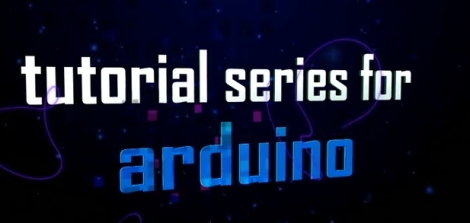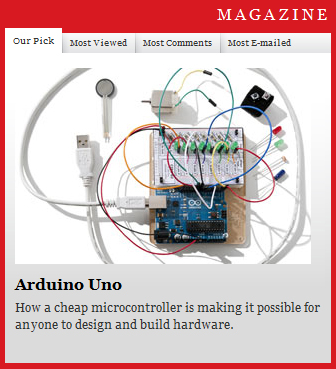CHEAP THERMOCAM AROUND 100$
– March 14th, 2011

[Max] forwarded me an impressive project about a DIY Themal Camera. The overall cost for building it is around 104$, compairing to professional products ranging from from 2000$ to 30.000$.
after some time of research I want to present my latest project called “Cheap-Thermocam”. It enables to create thermal images of houses, electrical devices or other things. An infrared sensor is mounted on two servos for moving it up/down – left/right. For an optical image of the scanned area, a webcam is installed under the sensor. An easy to install computer software written in JAVA shows a preview of the webcam image and then collects all the temperature data neccessarry to create the thermal image. To do this, 1344 single points are measured in about 2 minutes, this is a rare resolution of 42×32 Pixels. The advantage of my project compared to commercial thermal cameras is obviously the price. Another positive aspect is that the pictures can be analysed and edited with my easy to use pc software. The whole project can be built in 2-3 hours without any difficult parts do be soldered.
Related Arduino projects about this theme can be seen here (DIY Thermal Imaging System for under $200) and here (Thermoscanner). All Codes are provided
via [CheapThermocam]
ILLUTRON SHIP GETS REMOTE-CONTROLLED
– March 11th, 2011
[Christian] from Illutron hackespace in Copenhagen managed to control and monitor this ship (Illutron) from the internet.
Today, it is finally possible to remotely monitor the ship. In essence: I am sitting in the warm comfort of my home, and with a glance at my phone, I can see, that the sinking alarm in the machinery room is dry. The light is out in the Mess room. All is nice at our little lovely ship out there in the dark, cold Sydhavn.
Actually, behind this lies a pretty clever system (I think I am allowed to brag a little, that makes it possible to monitor events on sensors on the ship, and trigger that messages is sent to Google
Talk users. (if you have a gmail, you have Google Talk) It is also possible via your chat, to send commands to the ship, and get reading from sensors when you want them.[...] Basicly, we can monitor anything, that can be plugged into an Arduino board. One thing I would love, is a temperature sensor for the Mess room. Bring the sensor, and I will mount it So far, we have
– a light sensor, that reports if it is light or dark in the Mess (the electronics room)
– a new water level sensor. I didn’t dare mess with the old system, so I am putting in new float sensorsThings can still be developed a lot, and it will be – Suggestions would be happily received.
Thanks and hello to Stephane and Olle that came by to visit us at the sunday meeting, and ended up staying all evening – for help with sensor mounting and JavaScript improvements!
Have a look at this Ship Automation project on [Christian Liljedahl project page]and [Illutron site]
WE ARE LOOKING FOR FORUM MODERATORS
– March 11th, 2011
Updating the forum has been one of our best investments so far. The communication flow has increased dramatically (I will post about this soon, including some graphs) but also the need to headhunt community members to give a hand in making the forum and the web the best resource possible for Arduino interested people and related initiatives.
Please take a look at this post:http://arduino.cc/forum/index.php/topic,54857.0.html and put your name at the bottom if you want to become one of our moderators. We will choose people based on their experience and contribution.
NOT DESIGNED TO BE DUMPED
– March 10th, 2011
Arduino itself is something used to do things (or repair / reuse them). It’s very difficoult for you to break it, and it’s not the kind of consumer electronics product depicted in the video above (I must say me myself I’m treated like a kind of dump by my friends: people brings me all kind of electronic junk in order to be reused. I think this is common to most of our readers). But still I find this video strongly related to DIY world, our way to design things, our personal daily habits. We strongly advice you to spend your next 7’46” in watchin this video.
(by the way, long ago Arduino opted for Carbon Neutrality for the majority of its products).
via [HistoryOfElectronics]
MUST-SEE BEGINNER TUTORIALS FOR ARDUINO
– March 9th, 2011
[Jeremy] made ten Tutorials about Arduino worth our “All Stars” category. He talks about different themes: Blinking Leds [Intro & #2], Electrical Engineering [#3], Analog Inputs [#4], Motors & Transistors [#5], Serial Communication & Processing [#6], I2C & Processing [#7], SPI Interfaces [#8], Wireless Communication [#9] and Interrupts [#10].
Thanks to a generous sponsorship from element14, I’m putting together a tutorial series on using the arduino microcontroller platform! The arduino is a platform that I’ve done several projects with, and I think it is the best possible way for beginners to get acquainted with electronics. This tutorial series will be aimed at beginner users, but I’m hoping to keep it going with some more advanced topics a few episodes into the future.
thanks Jeremy! ++
via [JeremyBlum] [Element14]
BAT GOGGLES FOR VISUALLY IMPAIRED FROM USI
– March 8th, 2011
It seems like part of the Arduino projects lately hang around “visually impaired” solutions. This is the research from Alex Tomic form USI in Lugano.
The “Bat Goggles” are a general-purpose set of visual aids to assist those with low or no vision to sense obstacles. While the original project envisioned the sensors being attached as part of a helmet or eyeglasses, after experimentation it was determined that the tool is much more useful if the proximity sensors are movable, allowing them to be placed on the hands, feet, knees, or any other extremity. This allows more flexibility in exploration of environments and extending the effective range of the extremity.In a free-moving use case, the user holds sensors in each hand. The proximity sensors serve as a virtual extension of the user’s hand, allowing him or her to check for the existence of objects without touching them. This can be useful in situations where it may be desirable to detect delicate objects that could be damaged if touched with excessive force (eg. a vase or lamp).
Check out project and review(pdf).
via [AlexTomicProjectPage]
KINECT CONTROLLED DELTA-ROBOT
– March 7th, 2011
Everybody’s amazed about the incredible things done with Kinect and Processing + Arduino. Tutorial need!
This is a project in development for the module “Digital Ecologies”, at the Bartlett’s Adaptive Architecture and Computation MSc. – University College LondonA Delta-Robot is controlled by a Kinect through Processing and Arduino. The movements of the performer control directly the position of the robot’s effector, and the rotation and opening of the gripper.
Once the plattform is properly calibrated (still a little rough round the edges!), several autonomous behaviours will be implemented.
have a look at [resources]via [KinectHacks]
MIT TECHNOLOGY REVIEW ON ARDUINO
– March 4th, 2011
Technology Review of March/April 2011 has an article about the Arduino written by Erica Naone.
As electronic devices got more complicated in the past few decades, it became increasingly difficult and expensive to tinker with hardware. The 1970s garage engineers who built their own computers gave way to geeks who programmed their own software. But now the rise of open-source hardware is paving the way for a return of build-it-yourself electronics. Creators can start with devices such as the Arduino, an inexpensive control board that’s easy to program and can hook up to a wide variety of hardware. People can create projects that range from blinking light shows to more sophisticated efforts such as robotics. The Arduino started with designers in Italy, who license the boards to manufacturers and distributors that sell official versions for less than $50. The Arduino designers freely share the specifications for anyone to use, however, and third-party manufacturers all over the world offer versions of their own, sometimes optimized for specific purposes.
Magazine stories are paid, so unless you subscribe you won’t have the pleasure to read the article.
via [Massimo's morning twitts] source [Technology Review]
SIMPLENZAR GETS MORE COMPLICATED
– March 3rd, 2011
Arduino sending MIDI messages to control some other geeky machinery for electronic music, on breadboard.
Lately SimplenZAR becomes a self-made shield.
Late again an Arduino is developed just to fit that shield and set the original Arduino free to for the next project. Bravo!
WIFI NETWORK VISUALIZATION
– March 2nd, 2011
Very interesting visualization of the wi-fi network using Arduino and a wi-fi antenna. It’s the same concept of the other “Immaterial” movie: the visualisation of an RFID antenna range.
This film is about investigating and contextualising WiFi networks through visualisation. It is made by Timo Arnall, Jørn Knutsen, Einar Sneve Martinussen. The film is a continuation of our explorations of intangible phenomena that have implications for design and effect how both products and cities are experienced. Matt Jones of BERG has summarised these phenomena as ‘Immaterials’, and uses sociality, data, time and radio as examples. Radio and wireless communication are a fundamental part of the construction of networked cities. This generates what William Mitchell called an ‘electromagnetic terrain’ that is both intricate and invisible, and only hinted at by the presence of antennas (2004, p.55).











0 comentarios:
Publicar un comentario